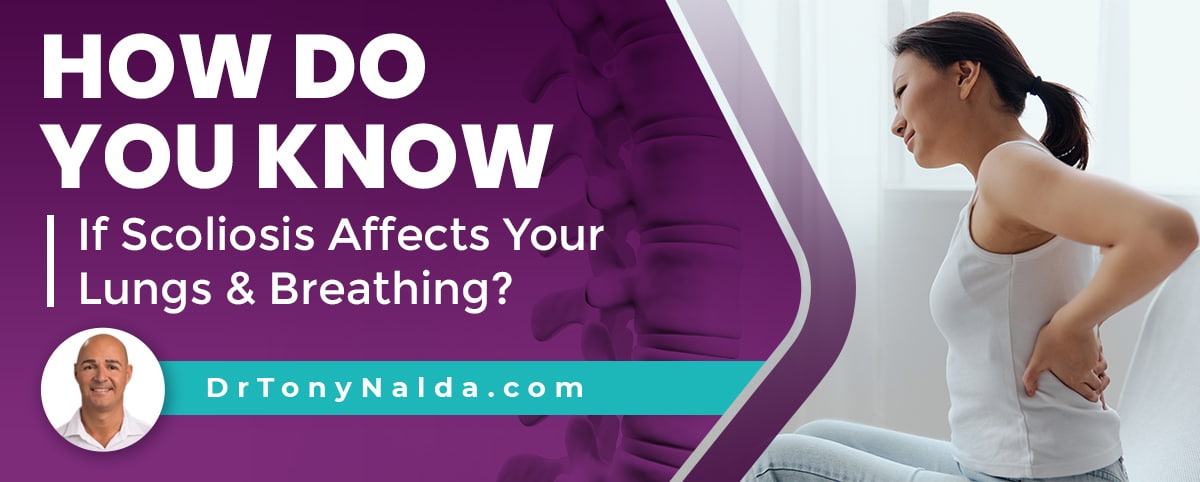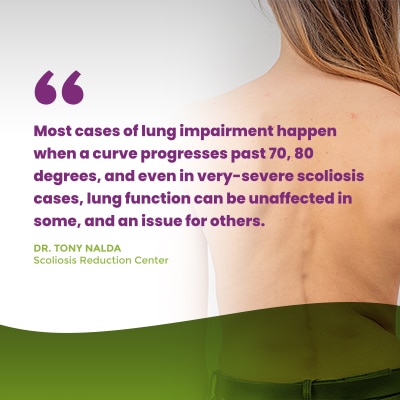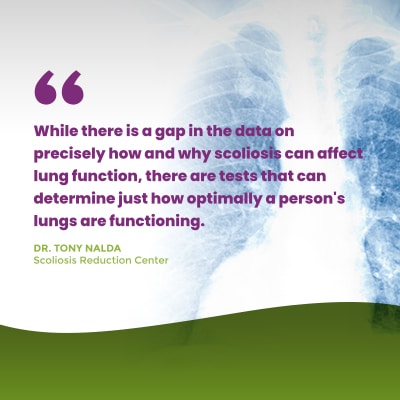How Do You Know If Scoliosis Affects Your Lungs & Breathing?

Although scoliosis is a spinal deformity characterized by the development of an unnatural spinal curvature, as the spine is involved in the function of virtually every working system within the body, spinal conditions can affect a number of things, pulmonary function being one of them.
As a condition that can range from mild to very severe, what one patient experiences is not indicative of what others will face. Scoliosis can affect lung function, but is most common in severe scoliosis and/or scoliosis patients who put higher-than-average demands on their respiratory system.
Let's start our discussion of scoliosis and pulmonary function by first exploring how a person knows if they have scoliosis.
Table of Contents
Being Diagnosed With Scoliosis
With current estimates of people affected by scoliosis at between 6 and 9 million people in the United States alone, many people are being diagnosed.
In order to be diagnosed with scoliosis, three parameters have to be met: there has to be an unnatural sideways spinal curve, with a rotational component, and Cobb angle measurements of at least 10 degrees.
The spinal rotation is what makes scoliosis a 3-dimensional condition as the spine twists, as well as bends unnaturally to the side.
Cobb angle is a type of measurement taken during X-ray that tells me how far out of alignment a scoliotic spine is, and the higher the Cobb angle, the more severe the condition:
- Mild scoliosis: Cobb angle measurement of between 10 and 25 degrees
- Moderate scoliosis: Cobb angle measurement of between 25 and 40 degrees
- Severe scoliosis: Cobb angle measurement of 40+ degrees
- Very-severe scoliosis: Cobb angle measurement of 80+ degrees
So as you can see from the wide range of severity levels, there is going to be a significant range in experienced symptoms as well.
In fact, mild or moderate scoliosis patients don't always experience noticeable symptoms, and in the condition's most-prevalent form, adolescent idiopathic scoliosis, diagnosed between the ages of 10 and 18, detecting early-onset scoliosis can be a challenge.
In addition, scoliosis is progressive, meaning it has it in its very nature to worsen over time, particularly if left untreated, or not treated proactively.
So where a scoliosis is at the time of diagnosis, and what it affects, are not indicative of where it will stay; even mild scoliosis cases can easily progress to moderate, severe, or very severe scoliosis cases.
Even if a person doesn't experience any changes to pulmonary function initially, that doesn't mean those types of issues can't develop over time, alongside progression; only proactive treatment can counteract the condition's progressive nature.
When pulmonary function is affected by scoliosis, is it overt, or subtle?
How Noticeable is Lung Impairment Related to Scoliosis?
In most cases of scoliosis-related disruptions to lung function, this occurs when the condition is severe.
In addition, it is most common when scoliosis affects the thoracic spine, and in curves that are 40+ degrees.
 Most cases of lung impairment happen when a curve progresses past 70, 80 degrees, and even in very-severe scoliosis cases, lung function can be unaffected in some, and an issue for others.
Most cases of lung impairment happen when a curve progresses past 70, 80 degrees, and even in very-severe scoliosis cases, lung function can be unaffected in some, and an issue for others.
When I feel confident enough to tell a patient that lung function is likely to be affected is when curves break 100 to 120 degrees; at this range, it's likely that lung impairment will be an issue.
However, even in some very-severe scoliosis breathing issues, lung deficiencies can be functional, meaning patients don't necessarily know they are experiencing an impairment; these types of patients are likely to continue with their daily tasks and responsibilities without disruption.
As mentioned earlier, people who place higher-than-average demands on their respiratory muscles and systems are the ones most likely to notice a disruption to lung function.
Professional athletes, long-distance runners, etc are likely to notice changes during periods of intense physical activity; changes can include lung capacity, breathing problems during long bouts of intense exercises, shallow breathing problems, and feeling unable to catch a breath.
Average demands on respiratory systems made by average people are unlikely to reveal a scoliosis-related lung deficiency; it's only likely to be noticeable to professional athletes who put extra demands on their lung tissue and lung volume.
Although it can be difficult to notice scoliosis-related changes to lung capacity, there are tests that can be done.
Tests for Determining Lung Capacity
 While there is a gap in the data on precisely how and why scoliosis can affect lung function, there are tests that can determine just how optimally a person's lungs are functioning.
While there is a gap in the data on precisely how and why scoliosis can affect lung function, there are tests that can determine just how optimally a person's lungs are functioning.
In patients with mild, moderate, or severe scoliosis, a test known as spirometry can measure a patient's lungs to monitor their ability to breathe out: expiratory volume.
The spirometry test is a less-reliable version of the superior pulmonary-function test, the plethysmography: involving sitting in an airtight glass cube while an instrument measures the changes in lung volume that occur throughout the body.
The plethysmography test involves the use of high-end equipment that is not readily available and/or accessible in many places, which is why the spirometry is the more commonly used test for measuring whether or not the lungs function properly.
So for those experiencing scoliosis-related lung impairment, what can be done about it?
How to Treat Scoliosis-Related Lung Impairment
When scoliosis-related lung impairment is detected, the question is how best to address it.
Traditional scoliosis treatment would likely respond with surgical treatment, but there is no clear evidence that spinal fusion used to reduce a curve will improve lung capacity.
In fact, there is a school of thought that surgery, even when successful at reducing the size of a scoliotic curve, can worsen lung capacity because a fused spine is more rigid.
When a section of the spine is fused together and rods and screws are holding the spine in place, there can be a significant loss in spinal flexibility and range of motion, and that level of spinal rigidity is associated with lung function impairment.
Here at the Scoliosis Reduction Center, my approach to addressing lung impairment, and any scoliosis symptoms for that matter, is to treat the condition proactively and to impact it, first and foremost, on a structural level.
Once I start to see structural results achieved through condition-specific chiropractic care, related symptoms, such as lung issues, are improved as the spine's healthy curves are restored and spinal biomechanics are improved.
Unhealthy spinal curves can affect the chest wall, and this can impact respiratory muscle strength and cause respiratory muscle weakness.
If an unnatural spinal curve causes the rib cage to rotate, pulmonary restriction can occur as there is less room for the lungs to expand, but if that unnatural spinal curve is reduced, so too is the rotation, and space is opened up for the lungs to function optimally within.
I can also test a patient's lung capacity before and after treatment to monitor for changes.
Conclusion
There is a lot we don't know about idiopathic scoliosis, particularly in terms of causation, but while we don't fully understand what causes its development, we most certainly know how to treat it effectively.
When people first receive a diagnosis of scoliosis, there is a lot of concern about potential complications and how bad the condition can get; one such concern is whether or not lung impairment will be an issue, and this is particularly concerning to athletes.
If scoliosis is very severe and likely to cause some level of lung impairment, is it likely to disrupt a person's ability to function properly and keep up with their daily tasks and responsibilities?
In general, the larger a scoliotic curve is, the more likely it is to cause noticeable symptoms and related complications such as lung impairment; that being said, however, even in some cases of very-severe scoliosis, lung impairment isn't all that noticeable.
Patients who are most likely to notice a change to lung function are those who place high demands on their respiratory systems, such as athletes and long-distance runners: people who are participating in high-impact high-intensity physical activity and sports.
For patients who notice changes to lung capacity, this commonly involves difficulty with inhaling deeply while exercising for long periods of time
Here at the Center, when a lung-capacity issue develops, my treatment approach is to reduce the curvature that's causing the impairment, so regardless of whether it's more the bend in the spine, or spinal rigidity, that's causing the impairment, as the spine's healthy curves are restored, the lungs regain lost space, improving lung volumes.
In most cases of scoliosis-related lung impairment, the changes don't cause a noticeable disruption to daily life, meaning the lungs maintain their function, but for those wanting to know whether or not their lung function has been affected, there are certain tests that can be performed.
Dr. Tony Nalda
DOCTOR OF CHIROPRACTIC
After receiving an undergraduate degree in psychology and his Doctorate of Chiropractic from Life University, Dr. Nalda settled in Celebration, Florida and proceeded to build one of Central Florida’s most successful chiropractic clinics.
His experience with patients suffering from scoliosis, and the confusion and frustration they faced, led him to seek a specialty in scoliosis care. In 2006 he completed his Intensive Care Certification from CLEAR Institute, a leading scoliosis educational and certification center.
About Dr. Tony Nalda
 Ready to explore scoliosis treatment? Contact Us Now
Ready to explore scoliosis treatment? Contact Us Now





